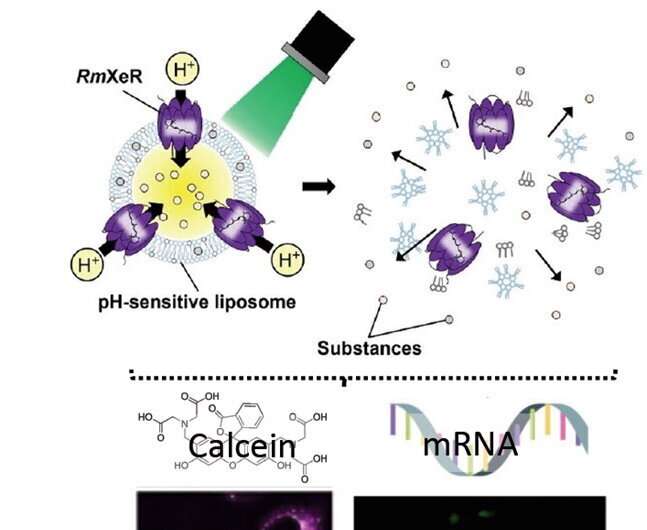This article has been reviewed according to Science X's editorial process and policies. Editors have highlighted the following attributes while ensuring the content's credibility:
fact-checked
peer-reviewed publication
trusted source
proofread
New light-responsive carriers for intracellular substance delivery

Artificial lipid bilayer vesicle liposomes, also called proteoliposomes, are specialized systems capable of incorporating various molecules, such as chemicals and drugs. Their unique properties make them ideal carriers for delivering substances inside cells. However, they must possess the dual characteristics of high stability in extracellular environments and low stability in intracellular environments.
Several techniques have been developed to regulate the stability of liposomes in a condition-dependent manner, with pH-sensitive liposomes being widely employed. A standard measure of acidity or basicity, the pH scale ranges from 1 to 14, with 7 standing for "neutral," like water, a pH below 7 indicating acidity and that above 7 indicating basicity. Interestingly, pH-sensitive liposomes can be triggered to release their contents when exposed to an acidic pH below 5.5.
In a new study, a team of researchers, led by Professor Yuki Sudo from Okayama University, Japan, have developed a precise method of releasing contents from pH-sensitive liposomes using light. "The study presents a novel nanomaterial called light-induced disruptive liposome (LiDL) and applies it to light-controlled intracellular substance delivery," explains Prof. Sudo. Their work, co-authored by Mr. Taichi Tsuneishi of Okayama University and Prof. Yuma Yamada of Hokkaido University in Japan, was published in the journal Chemical Communications .
The researchers utilized a protein called Rubricoccus marinus Xenorhodopsin (RmXeR), derived from a marine bacterium, to initiate acidification inside liposomes using light. To study the functionality of RmXeR within liposomes without interference from pH-dependent properties, they first developed pH-insensitive proteoliposomes using the lipid hydration method, combining phosphatidylcholine from egg yolk with cholesterol. Then, purified RmXeR was incorporated via the dilution method. The researchers estimated that the pH inside the thus obtained liposomes changed from 7.0 to 4.8 upon exposure to green light, rendering them suitable for light-induced disruption.
Subsequently, the team developed pH-sensitive proteoliposomes based on 1,2-dioleoyl-sn-glycero-3-phosphoethanolamine and cholesteryl hemisuccinate. Interestingly, before introducing RmXeR within the liposomes, the researchers incorporated a water-soluble fluorescent dye called calcein as a testing substance to evaluate their release capability.
By monitoring the fluorescence of calcein, they observed that its release from the liposomes occurred in a light-dependent manner, indicating that the liposomes effectively released substances when triggered by light. These pH-sensitive proteoliposomes, or LiDLs, displayed exceptional stability in the absence of light, maintaining their physiochemical properties when exposed to a temperature of 4°C for two weeks.
In the next phase of the study, the researchers introduced LiDL into mammalian HeLa cells to evaluate their effectiveness as carriers for delivering substances inside the cells. They monitored the cellular uptake for LiDLs, finding that the presence of LiDL, regardless of the inclusion of RmXeR, enhanced the uptake of liposomes by HeLa cells. This demonstrated the potential of LiDL as a carrier for intracellular substance delivery. To further improve the intracellular delivery efficiency, the researchers introduced a chemical called stearyl octaarginine into LiDL. This enhanced version, called LiDL-R8, exhibited significantly better performance compared to LiDL.
These findings highlight the utility of LiDL for the intracellular delivery of chemicals as well as biomolecules. "With LiDL, drug delivery can be controlled by light, potentially leading to advances in various therapies," emphasizes Prof. Sudo. Going forward, the team aims to enhance the content release efficiency by thoroughly characterizing the structure of the liposomes and optimizing the experimental conditions.
In effect, LiDLs hold great promise as optically controllable carriers for improved drug delivery. These liposomes offer enhanced efficacy without causing side effects, showcasing exceptional extracellular stability and controllable intracellular instability. "Our study will contribute towards ensuring healthy lives and promoting well-being for people of all ages, which ties in with one of the Sustainable Development Goal (SDG3) of the United Nations," concludes Prof. Sudo.
More information: Taichi Tsuneishi et al, Development of light-induced disruptive liposomes (LiDL) as a photoswitchable carrier for intracellular substance delivery, Chemical Communications (2023). DOI: 10.1039/D3CC02056H
Journal information: Chemical Communications
Provided by Okayama University





















